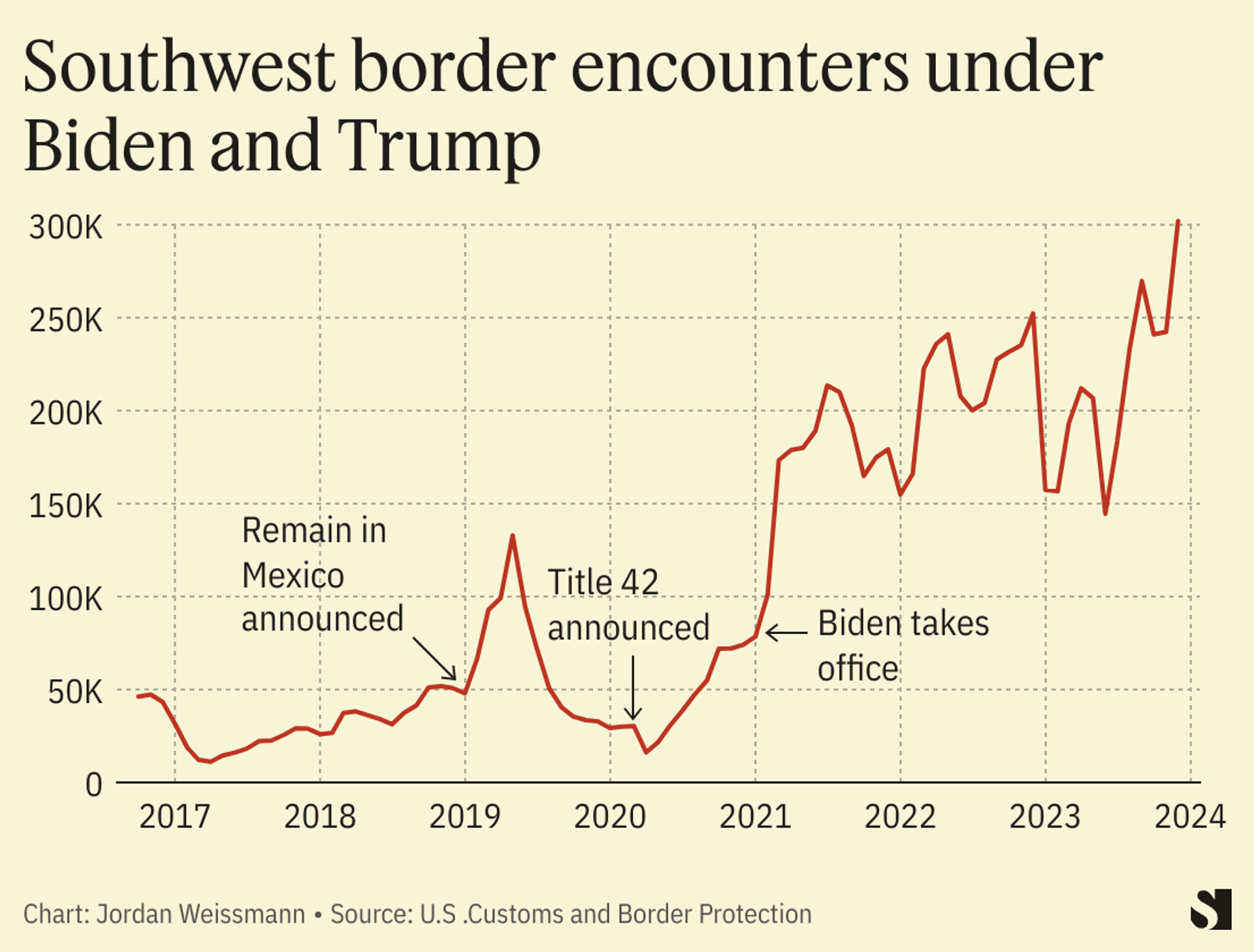The News
The political fight over the Senate’s bipartisan border deal, which unceremoniously collapsed on Tuesday, in many ways revolved around a single question: Did Donald Trump already figure out how to solve the problem?
Critics of the proposal, from conservatives in Congress to the former president himself, argued there was no need for new legislation to fix the border, because Trump had shown it could be done through executive authority alone. All President Biden needs to do, they claim, is return to his predecessor’s policies.
“You don’t need a border bill,” Trump said in a recent radio interview, as he drummed up opposition to the package. “We had the safest border in the history of our country. I didn’t need a bill.” In a Truth Social post Tuesday, he went further: “ALL A PRESIDENT HAS TO DO IS SAY, ‘CLOSE THE BORDER,’ AND THE BORDER WILL BE CLOSED. A COSTLY NEW BILL IS NOT NECESSARY!”
Supporters of the doomed deal argued that Trump and his allies were rewriting history. Crossings repeatedly hit new highs during Trump’s presidency, they point out. Trump was also sometimes stymied by the courts when he acted unilaterally, because the right to request asylum regardless of where a person enters the U.S. is currently embedded in immigration law. At times, he demanded Congress help him get around these issues by passing new legislation.
“There were times in 2019 where we had 4,000-plus people that were crossing the border illegally, and President Trump was using every lever that he had,” Sen. James Lankford, R-Okla., the bill’s lead Republican author, told reporters last week. “At the time he was asking for more authorities dealing with asylum.”
In a floor speech on Tuesday, Rep. Chip Roy, R-Texas, scoffed at Trump’s claim that a president could shut down the border at will. “With all due respect, that didn’t happen in 2017, ’18, ‘19, and ’20,” he said. “There were millions of people who came into the United States during those four years.” Roy opposed the Senate measure, but has argued that House Republicans should push to pass their own hardline legislation.
Joseph and Jordan’s View
Regrettably, there isn’t a simple, cut-and-dry answer to this debate. Even some mainstream immigration experts acknowledge that Trump’s policies likely helped bring down a massive spike in border crossings in 2019. And at their peak under Trump, the number of migrants arriving came nowhere near the current tally under Biden.
But conservatives also tend to exaggerate Trump’s successes at the border, conveniently ignoring that crossings began to surge again in 2020. There are also reasons to question just how much can be accomplished through executive authority now, as Biden looks to contain the migrant crisis without any new legal tools.
Step Back

Despite Trump’s promises to crack down on illegal immigration and an initial dip, crossings at the southern border steadily rose back to Obama-era levels during the first two years of his presidency. By 2018, he was calling on Congress to pass new legislation giving him more authority to tackle the problem.
“The only long-term solution to the crisis, and the only way to ensure the endurance of our nation as a sovereign country, is for Congress to overcome open borders obstruction,” Trump said in remarks at the White House. During that year’s midterms, migrant caravans snaking their way through Mexico figured heavily into the GOP’s campaign messaging.
In 2019, the crisis suddenly escalated. By May, the monthly number of apprehensions at the border more than doubled to their highest level in over a decade, thanks in large part to an influx of Central American families seeking asylum. But during the summer and fall, the number of arrivals suddenly plunged as quickly as it had risen, until the arrival of COVID finally slowed migration across the world.
The View From Trump World
Defenders of Trump’s record say his efforts were directly responsible for bringing border crossings back under control that year. In particular, they point to “Remain in Mexico” — the controversial policy that the president first stood up in January 2019, which required some asylum seekers to wait on the Mexican side of the southern border for their hearing with an immigration judge instead of entering the U.S.
Just under 70,000 migrants were sent back over the border under Trump’s program, a small fraction of arrivals during the final two years of his term. (Many of those individuals settled in temporary camps that became symbols of the policy, and were often criticized by pro-immigrant groups as a humanitarian mess.) But conservative immigration hawks argue the impact of “Remain in Mexico” was much broader than those raw numbers let on.
“Remain in Mexico” was a “complete game changer during the Trump administration, because would-be migrants learned, ‘Oh, I can’t just go to the border and say a few words of fear and that’s my ticket to get into the U.S. and then disappear and not be deported,‘” said Lora Ries, the director of border security and immigration center at the conservative Heritage Foundation. “We saw the caravans just completely dwindle once ‘Remain in Mexico’ was put into place.”
Trump wielded other tools to crack down at the border as well. Using the threat of tariffs, for instance, he pressured the Mexican government to deploy troops to strengthen enforcement at its border with Guatemala. During the pandemic, he rolled out the emergency measure known as Title 42, which allowed for the quick expulsion of asylum seekers under the auspices of public health.
But “Remain in Mexico” has been a special focal point for conservatives, who have argued that President Biden should revive the policy, which he ended following a lengthy court battle during which some states sued to keep the measure in place.
In an interview with Fox Business this month, Speaker Mike Johnson said reinstating the policy would be “the best way to reduce the flow” of migrants. “Just that one executive order alone by President Biden, which he could do this morning, would reduce the flow by 70%,” he added. On Wednesday, House Armed Services Committee Chair Mike Rogers said that if Biden wanted to unlock another round of aid to Ukraine, he would need to agree on restarting “Remain in Mexico.”
The View From Other Immigration Experts
Some mainstream immigration analysts also give Trump’s policies credit for bringing the number of border crossings back under control in 2019, though they tend to put somewhat less weight on “Remain in Mexico” and more on the former president’s deal with Mexico to step up its own migration enforcement. Along with a handful of other actions, those moves had a “dramatic effect on the scale of migrant arrivals,” according to a January report by the Migration Policy Institute.
The caveat? Trump’s approach was “successful for particular periods of time,” said Doris Meissner, director of the think tank’s U.S. immigration program. But those policies “did not have a lasting effect.” By mid-2020, border crossings began to rapidly shoot up again, despite the pandemic. A large share of the new migrants were single men who tried to enter the country repeatedly after being expelled under Title 42, turning the border into something of a revolving door.
Others note that, despite his best efforts, Trump ended up allowing a large number of asylum seekers into the country while their cases were processed — exactly what Biden is criticized on the right for doing now. During its final two years, Trump’s administration released 713,000 immigrants into the US, or 52% of all people crossing the border, per a recent Cato Institute analysis. By comparison, the Biden administration released 49% of migrants entering between ports of entry in the first two years, totaling 2.5 million.
“The prior administration had to release hundreds of thousands of people because it lacked the ability to remove them as quickly as they were coming in,” David Bier, the associate director of immigration studies at the Cato Institute and author of the analysis, told Semafor. “So the idea that they solved this problem, it’s certainly not the case.”
The View From Mexico
Though the White House is reportedly considering taking new executive actions to deal with the border, there are practical and legal reasons why it could be difficult for Biden to simply return to Trump’s policies, as Republicans have suggested.
Getting cooperation from Mexico is already a challenge. The country’s government agreed to the original “Remain in Mexico” program, but has indicated it would resist any effort to restart the controversial program in the future. In December, Mexican President Andrés Manuel López Obrador said he wanted the U.S. to remove sanctions from Venezuela and Cuba in return for more help with border issues.
The View From The Courthouse
Reviving a program like Title 42 could be difficult, too, given that Trump legally justified it as an emergency public health measure during the pandemic. “It would probably face some pretty significant legal challenges because of things like the fact that the government has lifted some of the other emergency declarations around COVID-19,” said Rebekah Wolf, a senior advocacy strategist at the American Immigration Council.
Contra his recent tweets, Trump himself frequently found his efforts to limit asylum claims tied up in court. For instance, the administration’s efforts to impose a so-called transit ban — which would effectively bar migrants from claiming asylum if they travel through a third country like Mexico on the way to the U.S. — were twice struck down by federal judges. (The cases were never settled at the Supreme Court.)
Notably, Biden is now defending his own version of the transit ban in a federal appeals court. The policy is in effect while the case plays out, much to the chagrin of pro-immigrant groups.
“Biden has already taken steps to address the border that are as restrictive or more restrictive than what his predecessor took,” said Keren Zwick, the litigation director of the National Immigrant Justice Center. “In fact, we’ve seen him adopt a number of extreme anti-immigrant policies, which are as illegal under this administration as they were under the prior one.”
